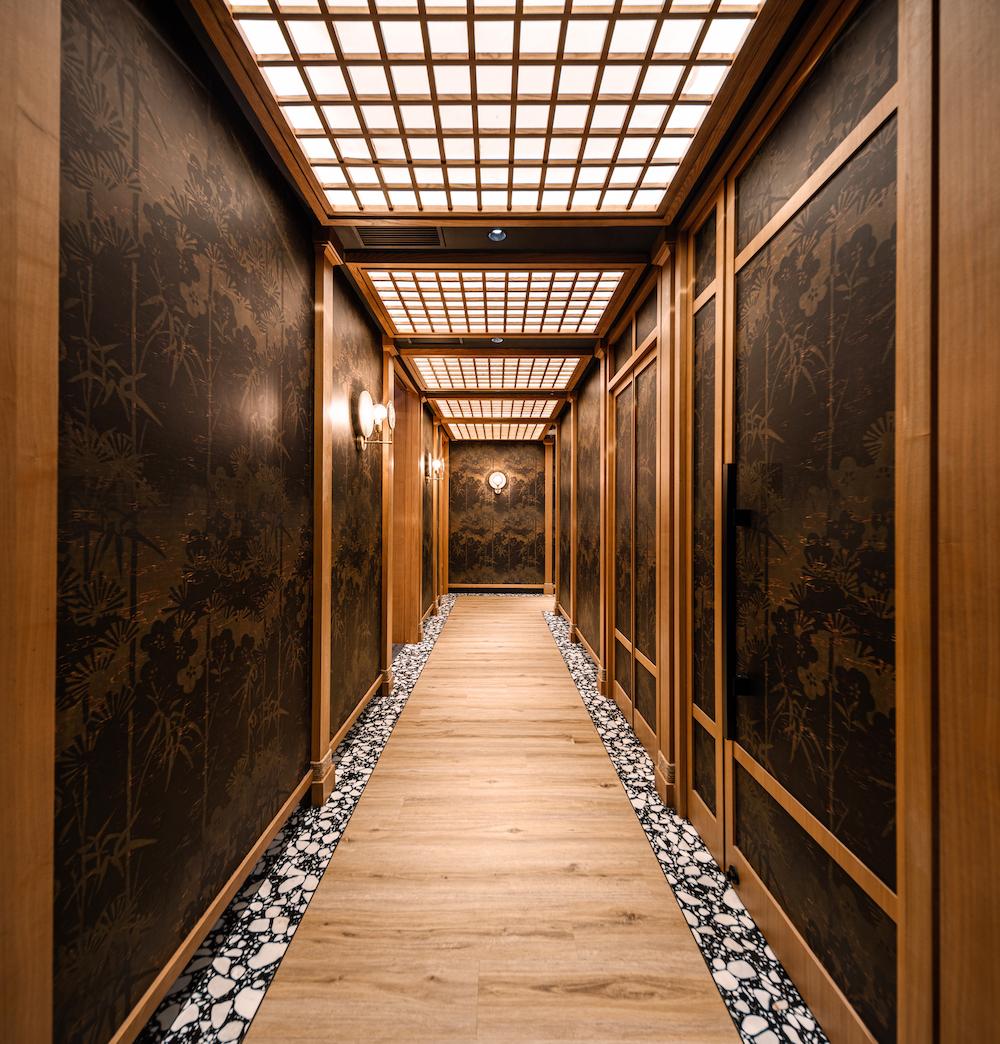The atmosphere of Japanese theatre (noh) begins at the entrance of Restaurant Hanasasuki, a traditional teppanyaki restaurant. It gradually leads people into a performance space where the chefs showcase their skills in an intriguing display.
The Japanese word "noh" means skill and talent. It's the primary form of classical Japanese dance and drama with a history tracing back to the 14th century or even earlier. Noh theatre usually centres around stories from traditional Japanese literature, with careful attention paid to the stage design and costumes, and may involve the use of masks or fans by singers and dancers. It is one of Japan's ancient performing arts. The design team of Greyscale an interior design company in Hong Kong, drew inspiration from Noh theatres to create Restaurant Hanasasuki in Causeway Bay.

Greyscale's designers carefully studied a Noh theatre's stage architecture and layout. Before the performance, the Noh actors would prepare in a space called "The Mirror Room." The entrance to the restaurant represents this space, with design elements such as folding fans and circular shapes on the feature walls and ceiling mirrors that create a theatre-like ambience as if the moon is suspended in mid-air. Serena Yeung, the Deputy Director of Greyscale, explained that the entrance features a pair of fans which draw the eye, inspired by the traditional use of fans as props by Noh dancers. Sometimes they would dance with the fans, and other times they would use the fans to mask their faces. The entrance walls are coated with metallic paint to evoke a sense of history, while the floor is paved with stone tiles that conjure images of the ancient stone paths of Japan.

The 3,000-square-foot restaurant has four VIP rooms named Stages 1, 2, 3 and 4. Each room is like a stage where the chefs perform their culinary skills. Guests enter through the entrance and pass through The Bridgeway, a hallway that leads to each room. The Bridgeway is modelled after an outdoor environment, with wallpaper depicting cherry blossom patterns on both sides. To ensure symmetry on each screen wall and to reflect Japanese architectural sensibilities, Greyscale's design team calculated each wall and wooden pillar with precision. The wooden flooring and pebble-patterned tiles are placed on both sides to create an outdoor atmosphere. The ceiling features wooden beams, and light shines through a white screen, creating a gentle and warm natural light.

Walking along the hallway, guests slowly enter the "stages" (VIP rooms), which adopt a red or green theme. The red room has red wallpaper and grey slate tiles on the floor. The wall lamps have a Japanese fan shape, and the performer - the chef - is in the centre of the stage to showcase their skills to the diners. Serena said, "The red-themed VIP room has a wooden ceiling structure inspired by traditional theatre architecture. We hung hemp rope, a building element commonly found in Japanese theatres, in the room. They used rope to secure the wooden pillars."

As for the green-themed VIP room, some walls are covered with dark green wallpaper and complemented by grey-green chairs, giving a sense of calmness. Traditional Japanese architecture often uses wood as the main structure, and the green-themed VIP room draws inspiration from conventional theatre stages, with the chef performing in the centre of the stage for diners to appreciate their culinary skills.
Serena adds, "This is where you watch the chef perform. We carefully arranged the lighting to create a theatrical atmosphere for diner, hoping they'll leave with unforgettable memories. We want people come and enjoy the food and also experience a Japanese dining culture brought by teppanyaki. Here, having teppanyaki allows you a cultural, experiential and theatrical experience."









